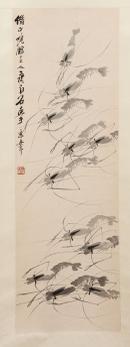Lot #37

Čchi Paj-š´ (QI Baishi) (1864–1957)
Shrimps
Estimate: 2,000,000 CZK – 5,000,000 CZK
1,800,000 CZK
A master of free ink painting, the Chinese painter Qi Baishi focused on capturing the essence of the given subject and life in motion. The hanging silk scroll Shrimps introduces one of his most iconic motifs. It depicts a group of crustaceans, their dynamic lines formed by gentle brushstrokes that evoke movement in crystal clear water. Thanks to masterful, expressive work with shades of ink, the composition gives a light and almost abstract impression, even as it remains a precise observation of anatomy. Qi Baishi used calligraphic abbreviation, which allowed him to capture the essence of movement with minimalistic brushstrokes. By blending wet and dry ink, he achieved subtle transitions that give the creatures volume and transparency. The theme of shrimp symbolised not only the beauty of nature, but also the author’s interest in simple folk motifs, which deviated from academic Chinese painting. His works in ink received a great international response and were exhibited in Czechoslovakia in the 1950s, where they influenced numerous artists. Shrimps is an excellent example of his skill in capturing life and movement with a few brushstrokes. This technically brilliant work is deeply rooted in the Chinese philosophy of art, which seeks beauty in simplicity and harmony with nature.
The scroll contains a calligraphic inscription, a typical element in Chinese ink painting. Qi Baishi often accompanied his works with short poems, personal notes, or dedications, and his handwriting was as expressive as the painting itself. The calligraphic inscription could be translated as: “Painted by the Master of the Pavilion of Poetry from the Borrowed Mountain, Qi Baishi.” This poetic pseudonym was used by the artist to reference the period when he “borrowed” a mountain as a refuge for his studio, and expresses humility and deep communion with nature. “Baishi” means “White Stone,” which was the artistic name he received from his teacher and under which he is known around the world. His 1928 work, A Trio of Squirrels and Grapes (inv. no. VM 5680), held by the National Gallery in Prague, contains the same seal. The calligraphic inscription, completed with a red seal, not only confirms authorship but also references the author’s life philosophy, which links the simplicity of the everyday world with the spiritual depth of traditional Chinese culture.
Assessed in consultation with specialists from the Chinese Institute of Art History in Beijing. The expert opinion of academic painter J. Straka is attached.





